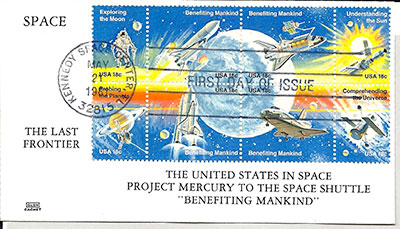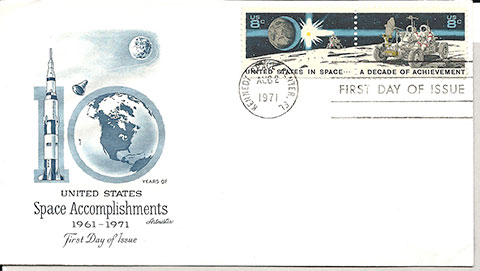Space Cover #574: Celebrating the Artwork of Robert McCallIf there was a king of contemporary space art it was Bob McCall. McCall's early space artwork was seen in science fiction pulp magazines sparking an interest in readers to envision a future of man in space. His large scale murals envisioning the history and future of space flight have captivated millions of viewers.
Along with my father Paul Calle, Bob was one of the original eight artists chosen to participate in the NASA Fine Art Program. The program initiated by NASA had many precedents in history. Combat artists of World War I and World War II, and the documentation of the Civil War by Winslow Homer come to mind. Artists have gone off to major wars involving our country from the Revolutionary War to the Middle East, documenting history in the making in a variety of medium.
But the roots go deeper into the 16th and 17th centuries when explorers were accompanied by artists who recorded the experiences they encountered. A French artist named Le Moyne traveled with an expedition in southeastern North America in 1564, and English artists John White painted at Sir Walter Raleigh's colony on Roanoke Island in 1585. Later, artists Karl Bodmer, George Catlin and others followed expeditions throughout the western United States and left us a visual record of the magnificent new frontier and it's native inhabitants.
The journals of the Lewis and Clark expedition give us a rare glimpse into the expansion of the Western United States. More recent examples have been the Air Force Historical Art Program and the National Park "Artists in the Park" Program, both of which Paul Calle and Bob McCall were also involved.
The purpose of the NASA Fine Art Program was to record for history, space exploration through the eyes of artists. McCall's involvement, like my father's, began with Gordon Cooper's Project Mercury mission and included Gemini, Apollo, uncrewed missions to Mars and Jupiter, and the space shuttle program.
The artwork that came out of this program celebrated both man and machine, and gave us a glimpse into the behind the scenes activities "at the Cape" as my dad always referred to his time in Florida
McCall's magazine illustrations and conceptual artwork for Stanley Kubrick's film, "2001: A Space Odyssey" will be remembered by many collectors and space enthusiasts for years to come but for me it is his philatelic artwork on U.S. postage stamps that will endure on millions of stamps and envelopes in philatelic collections worldwide.

For illustrative purposes here, I am showing my two favorite McCall stamp design issues, the 1971 United States in Space: A Decade of Achievement se-renent stamps depicting Earth, the Sun, and the lunar rover, and the 1981 Space Achievement: Benefitting Mankind block of eight stamps issue. This is classic Bob McCall artwork — colors that pop off of the page with a dynamic design envisioning where we have been and where we are going in space.
As many space collectors know, Bob McCall was a generous signer and I would be surprised if anyone reading this post doesn't have at least one or two First Day Covers signed by McCall. I sure do!!
As an added bonus, Bob would do a quick sketch to make these a treasured part of many space cover collections!
I was fortunate to know Bob through my father and had the pleasure and privilege to speak with him at many events throughout the years including a week at Cape Canaveral in the early 1980's on my own first assignment with the NASA Fine Art program. He was a wonderful mentor to young artists, and a wealth of knowledge about space to all.
"And the human spirit driven as it is, with insatiable desire to know, to explore, and to understand will continue forever to reach upward and outward." — Robert McCall













